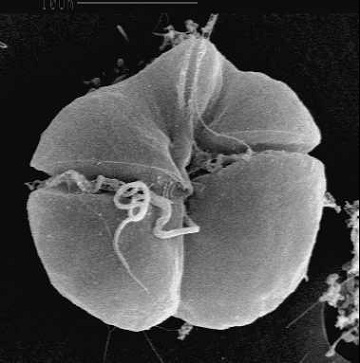Karenia_brevis.jpg

Karenia brevis commonly causes red tides. Credit: Florida Fish and Wildlife Conservation Commission
Have you ever wondered why the birds in Alfred Hitchcock’s famous movie The Birds seemed deranged? Hitchcock may have been inspired by a real event that took place in Capitola, California in 1961.
Shearwaters, a type of oceanic bird, ingested anchovies that were feeding on a bloom of toxic algae. The neurotoxin produced by the algae moved through the food web from algae to fish to bird and caused the birds to fly erratically.
Similar toxic algae afflict waters all over the world when conditions are ideal for algal populations to increase or bloom. The world’s coastlines are occasionally visited by red tides, which result from blooms of a single-celled algae known to science as Karenia brevis. This organism resembles both plants and animals. Like plants, it can create food using the energy in sunlight, but it also swims like an animal by moving a hair-like appendage.
What makes Karenia brevis dangerous is that it produces brevetoxin, a compound that causes Neurotoxic Shellfish Poisoning. Some organisms are more susceptible to the effects of brevetoxins than others. Shellfish, such as oysters, harmlessly accumulate brevetoxin during a bloom. However, humans that ingest the toxin-laden oysters experience unpleasant gastrointestinal and neurological symptoms. Red tides can cause massive fish kills, which in turn cause recreational and commercial fisheries to suffer.
This small but potent organism may seem like a menace, but it is an integral part of the marine food web and an important source of the earth’s oxygen supply. The challenge is keeping these little guys in check!
copyright 2006, The University of Texas Marine Science Institute


